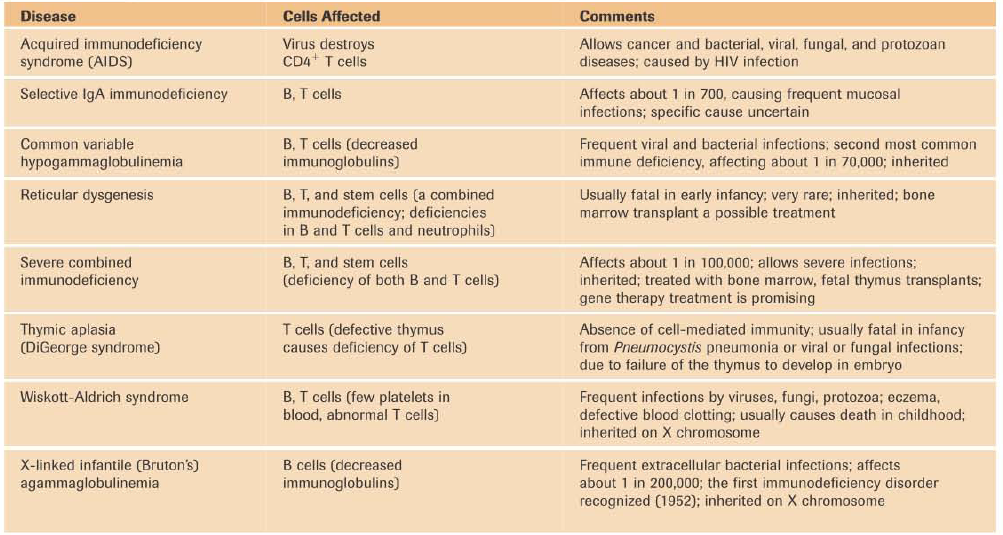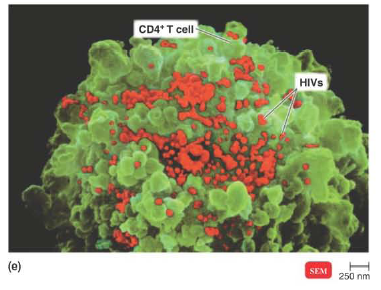
- •1. Congenital Immunodeficiencies
- •2. Acquired Immunodeficiencies
- •2.1 Acquired Immunodeficiency Syndrome (aids)
- •2.2 The Origin of aids
- •2.3 The Structure of hiv
- •2.4 The Infectiveness and Pathogenicity of hiv
- •Figure 4 Latent and active hiv infection in macrophages.
- •2.5 The Stages of hiv Infection
- •2.6 Hiv Vaccines
- •2.7 Chemotherapy
Immunodeficiencies
Plan:
Congenital Immunodeficiencies
Acquired Immunodeficiencies
Acquired Immunodeficiency Syndrome (AIDS)
The Origin of AIDS
The Structure of HIV
The Infectiveness and Pathogenicity of HIV
The Stages of HIV Infection
HIV Vaccines
Chemotherapy
The absence of a sufficient immune response is called an immunodeficiency, which can be either congenital or acquired.
1. Congenital Immunodeficiencies
Some people are born with a defective immune system. Defects in, or the absence of, a number of inherited genes can result in congenital immunodeficiencies. For example, individuals with a certain recessive trait, DiGeorge's syndrome, do not have a thymus gland and therefore lack cell-mediated immunity.
2. Acquired Immunodeficiencies
A variety of drugs, cancers, or infectious agents can result in acquired immunodeficiencies. For example, Hodgkin's disease (a type of cancer) lowers the cell-mediated response. Many viruses are capable of infecting and killing lymphocytes, lowering the immune response. Removal of the spleen decreases humoral immunity. Table 1 summarizes several of the better known immune deficiency conditions.

2.1 Acquired Immunodeficiency Syndrome (aids)
In 1981 , a cluster of cases of Pneumocystis pneumonia appeared in the Los Angeles area. This extremely rare disease usually occurred only in immunosuppressed individuals. Investigators soon correlated the appearance of this disease with an unusual incidence of a rare form of cancer of the skin and blood vessels called Kaposi's sarcoma. The people affected were all young homosexual men, and all showed a loss of immune function. By 1983, the pathogen causing the loss of immune function had been identified as a virus that selectively infects T helper cells. This virus is now known as human immunodeficiency virus, or HIV (Figure l).

Figure 1. Several human immunodeficiency viruses (HIVs), the causative agent of AIDS, budding from a CD4 + T cell.
2.2 The Origin of aids
HIV is now believed to have arisen by the mutation of a virus that had been endemic in wildlife in some areas of central Africa. Genetic studies of the virus have led to the conclusion that HIV-2 (a type of HIV that is weakly contagious and not often found outside of West Africa) is a mutation of a simian immunodeficiency virus (SIV). Mangabey monkeys in West Africa are naturally and harmlessly infected with this SIV. More recently, studies show that HIV- l (the primary HIV found worldwide in humans) is genetically related to another SIV that is carried by chimpanzees in Central Africa.
These SIV infections apparently crossed over relatively recently (well into the twentieth century) into the human population, known to eat "bushmeat." Mathematical models of the supposed evolution of HTV, by Bette Korber of the Los Alamos National Laboratory, calculate that the virus probably made the transition to humans around 1930. The disease may have smoldered with little notice as long as transmission was limited to small villages where rates of sexual promiscuity were lower. The virus could not have killed or incapacitated its hosts quickly; otherwise, it could not have been maintained in the village population. With the sudden end of European colonialism, the social structure of sub-Saharan Africa was disrupted. The population became urbanized; the developments that result from urbanization and contribute to an increase in sexual promiscuity, such as an increase in prostitution and the growth of highway transportation, are believed to be responsible for the spread of the disease.
